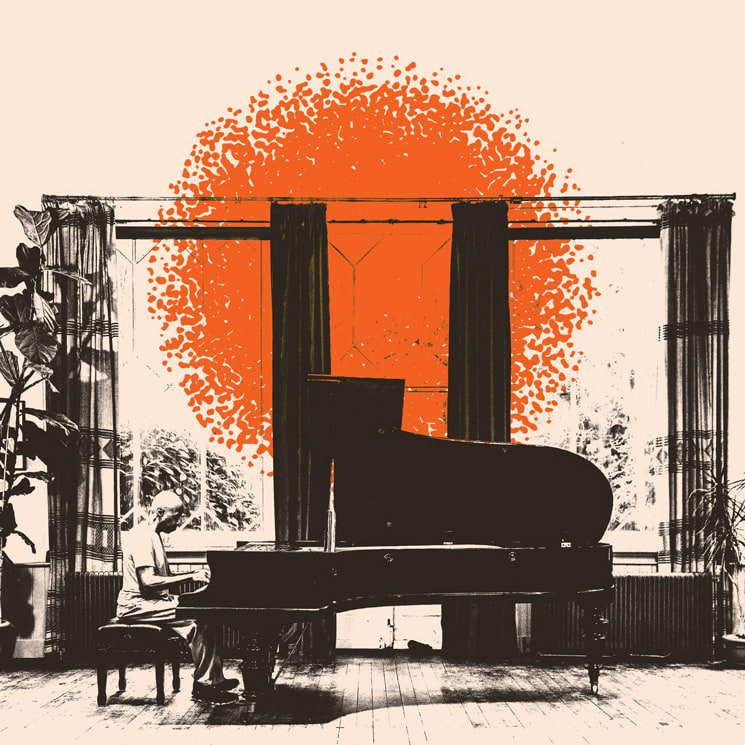When people tell the story of ambient music pioneer Laraaji, they usually start here: one day in 1978, as Laraaji was playing the zither in Washington Square Park, a man across the way heard him, strode over, and asked to make a record. The man was Brian Eno; the request was sincere. In 1980, the two collaborated on Ambient 3: Day of Radiance, a work that established Laraaji's signature sound — brilliant strokes of trance-like strings that, according to Laraaji, free up the listener's attachment to time.
It's a tidy origin story, and a true one, yet it tunes into Laraaji's life frustratingly late. What of the years before Brian Eno, the earlier moments in the artist's development? On his latest work Sun Piano, the 77-year-old multi-instrumentalist returns at last to the musical foundations of his young life. The result is a spacious collection of piano pieces, suffused with the sound of childhood — when every note was still a new one.
Laraaji — born Edward Larry Gordon — first came across the piano in the Baptist church where he spent his youth. On Sundays, things were quiet in the hours between Sunday school and church service. Laraaji had these moments to spend with the church piano, making of the silence what he wanted, filling it with sounds that were his. He'd imitate his favourite pianists — Fats Domino, Errol Garner, Oscar Peterson — and watch his fingers stumble into the patterns these players had made. Before long, he started to produce patterns of his own.
These childhood memories closely inform how, decades later, Laraaji went about creating Sun Piano. On the new album, the artist finally returns to his first instrument, as well as to a divine space like the one where he began to play. All recording sessions for Sun Piano took place in a huge Brooklyn church, with Laraaji improvising the instrumental sketches assembled on the release.
True to the form of ambient music, Sun Piano evokes a general atmosphere, rather than any particular melodic structure. And what an atmosphere it is: In Laraaji's able hands, the relatively well-mannered, polite instrument of the piano unburdens itself, emitting its own radiance into the quiet of the empty church.
It's an effect aided by producer Jeff Ziegler, known for his work with singer Kurt Vile and harpist Mary Lattimore. Here, Ziegler's production is light, roomy and lucid. Laraaji's melodies expand to fill the contours of the church — sounding out the high walls and windows, catching the light as it streams in.
There are standout tracks to be found — the chiming circles of "Lifting Me," the smooth peaks of "Temple of New Light" — but, mostly, Sun Piano is an extended meditation, best heard in full. There's both familiarity and surprise in the meandering course of its melodies: a fitting mix for a musical pioneer retracing the path he started on, while still charting ahead.
(All Saints Records)It's a tidy origin story, and a true one, yet it tunes into Laraaji's life frustratingly late. What of the years before Brian Eno, the earlier moments in the artist's development? On his latest work Sun Piano, the 77-year-old multi-instrumentalist returns at last to the musical foundations of his young life. The result is a spacious collection of piano pieces, suffused with the sound of childhood — when every note was still a new one.
Laraaji — born Edward Larry Gordon — first came across the piano in the Baptist church where he spent his youth. On Sundays, things were quiet in the hours between Sunday school and church service. Laraaji had these moments to spend with the church piano, making of the silence what he wanted, filling it with sounds that were his. He'd imitate his favourite pianists — Fats Domino, Errol Garner, Oscar Peterson — and watch his fingers stumble into the patterns these players had made. Before long, he started to produce patterns of his own.
These childhood memories closely inform how, decades later, Laraaji went about creating Sun Piano. On the new album, the artist finally returns to his first instrument, as well as to a divine space like the one where he began to play. All recording sessions for Sun Piano took place in a huge Brooklyn church, with Laraaji improvising the instrumental sketches assembled on the release.
True to the form of ambient music, Sun Piano evokes a general atmosphere, rather than any particular melodic structure. And what an atmosphere it is: In Laraaji's able hands, the relatively well-mannered, polite instrument of the piano unburdens itself, emitting its own radiance into the quiet of the empty church.
It's an effect aided by producer Jeff Ziegler, known for his work with singer Kurt Vile and harpist Mary Lattimore. Here, Ziegler's production is light, roomy and lucid. Laraaji's melodies expand to fill the contours of the church — sounding out the high walls and windows, catching the light as it streams in.
There are standout tracks to be found — the chiming circles of "Lifting Me," the smooth peaks of "Temple of New Light" — but, mostly, Sun Piano is an extended meditation, best heard in full. There's both familiarity and surprise in the meandering course of its melodies: a fitting mix for a musical pioneer retracing the path he started on, while still charting ahead.
